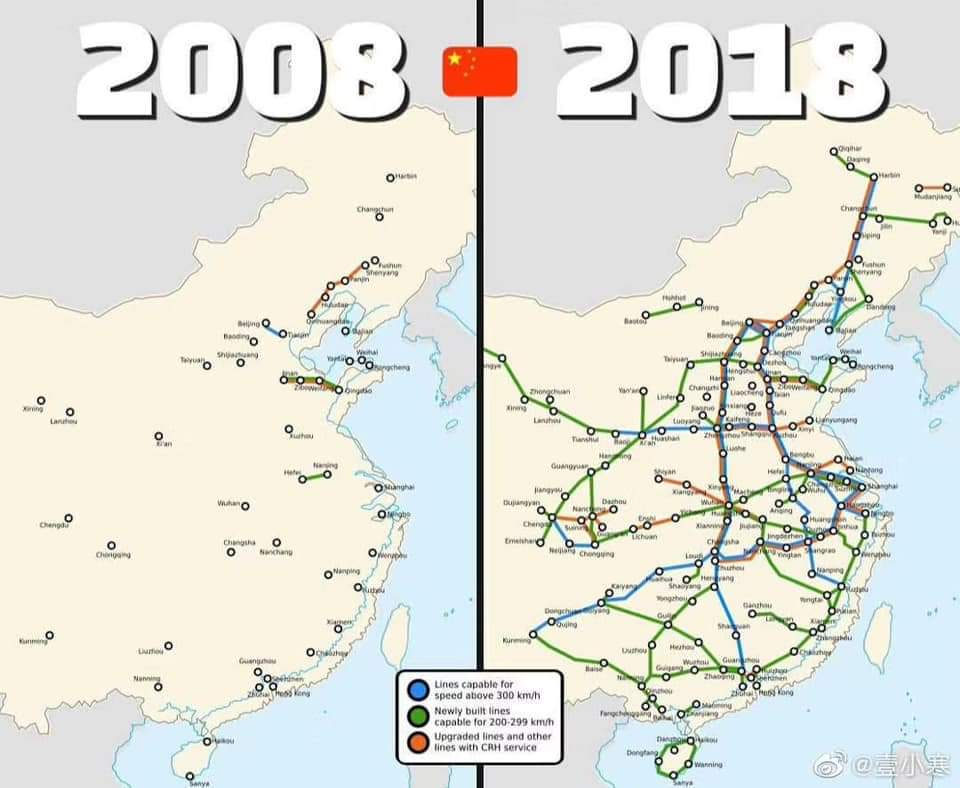A discussion on HackerNews
I would love to see a parallel universe, where collective transportation obtained the upper hand. Where countryside railroads are still operating, and where roads/highways haven’t consistently led to the expropriation of millions of people worldwide, and to the current car-oriented urban nightmare. See Ivan Illich for a demonstration that car-oriented urbanization is hostile and counter-productive, as opposed to what he calls “convivial tools” (empowering technologies).
Move to Japan (although the implementation there is imperfect as well).
I think Japan used to be the world leader in high speed rail, but now its down to #5, behind China, Spain, Germany and France.
This wiki chart is pretty sick
China’s highspeed rail progress is wild:

Any idea what kind of fuel these trains use?
I can’t find numbers on percentages of diesel vs electric ones, but I did find this:
China has over 100,000 kilometres (62,000 mi) of electrified railway.[42] With most trunk line heavy freight and long-distance passenger trains operated using high power electric locomotives, typically in excess of 7,200 kilowatts (9,700 hp) of power output.
Nice. Thanks very much.
Yeah good for them I guess. But I was specifically not talking about high-speed rail networks.
However, the definition of of that varies much anyways. What counts as a regular service trains in on country, can be sometimes promoted as a high-speed one in another.
I think the vital distinction is the cost. In Europe high-speed rail service costs ten times (or more) as much as regular rail service, and is largely incompatible in a mixed network with slower trains, resulting in a cut down of the latter.
I think China’s high-speed rail is a sort of hybrid that didn’t cost as much and mostly wasn’t build on top of an existing regular rail service, so my guess is that the result is probably better then what we see in Europe. They probably also didn’t as much push the costs on the ticket prices, so the regular user is less impacted by the absurdity of high-speed rail.
They have some public transport infrastructure but car is still king. I don’t think that’s what OP is talking about.
Compared to most other places the public train infrastructure in Japan is superb. Sure they also have lots of cars and roads, but overall you can get around with trains (and buses in rare cases) pretty well, even in rural places.
Yeah I agree it is much better than mosy places but it is still a far cry from an infrastructure that is designed around public means of transportation. It’s more like public transport had to be adapted to a cities that were built for on-road vehicles. I don’t dislike it but public transport has more room to be efficient, comfortable and extensive especially if it is given priority over cars.
Japanese cities are also for the most part pretty car unfriendly, that is why they have many tiny cars and vans that can be operated on narrow steep roads historically meant for pedestrians. Overall the city structure is pretty dense and a far cry from US standards that make it pretty much impossible to walk anywhere. But yeah, the car lobby is of course also strong over there.
On a side note (also see my comment further below), one of the reasons I think the Japanese regional train network is still quite healthy (besides a national obsession with trains) is that their Shinkansen high speed train is on an incompatible rail system, and thus does not (as much) push slower train developments out of consideration. Economics wise it is of course still a really bad idea to operate these high-speed rail networks, but in mixed systems like in Europe it has a really bad impact on service coverage.
On a related note: That is why I despise high speed rail networks. All over Europe they have resulted in inter-regional train services to be cut down to the bare basics and ticket prices have increased a lot.
High speed rail is just a stupid and dead end technology. It tries to compete with flights (which it can’t) at the expense of properly operated regional rail service and useful options like sleeper trains.
Never thought of it that way, but it definitely makes sense! :)



